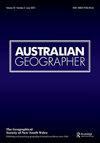协调定居(im)流动:探索澳大利亚地区难民人道主义移民的二次迁移模式和定居地理
IF 2
2区 社会学
Q2 GEOGRAPHY
引用次数: 0
摘要
国际移民在解决与人口老龄化和生育率下降有关的社会和经济挑战方面发挥着重要作用,这在澳大利亚地区是非常明显的。在吸引和留住移徙者仍然是一项挑战的政策领域,大量难民人道主义移徙者在没有任何政府直接政策干预的情况下,独立地被吸引到计划外的区域定居地点。然而,这些通常被视为“有机”或非正式的二次迁移模式尚未得到很好的理解。我们提出了新的见解,他们的流动性在澳大利亚地区使用二级数据集和主要研究。使用制度人种学方法,我们强调他们的运动并不像想象的那样“有机”。同时,通过“新流动”范式,我们强调了难民-人道主义移民的国际和国内移民之间的联系。我们通过关注家庭成员的不流动(由延迟和拒绝家庭团聚的移民政策构成)如何与澳大利亚的二次移民模式交织在一起,梳理出关系因素。随着区域社区接受难民-人道主义移民的二次移民的好处,我们表明,这些好处是由惩罚性的家庭团聚政策反常地支持的,这些政策可能对难民-人道主义移民的成功融合产生影响。本文章由计算机程序翻译,如有差异,请以英文原文为准。
Coordinating settlement (im)mobilities: exploring secondary migration patterns and settlement geographies among refugee-humanitarian migrants in regional Australia
International migrants play an important role in addressing the social and economic challenges associated with population ageing and fertility decline that are keenly felt in regional Australia. In a policy arena where the attraction and retention of migrants remains a challenge, large numbers of refugee-humanitarian migrants have, without any direct government policy intervention, independently gravitated towards unplanned regional settlement locations. However, these secondary migration patterns, often regarded as ‘organic’ or informal, are not well understood. We present new insights into their mobility in regional Australia using secondary datasets and primary research. Using Institutional Ethnographic methods, we highlight how their movements are not as ‘organic’ as imagined. Simultaneously, through the 'new mobilities' paradigm, we highlight the link between international and internal migration of refugee-humanitarian migrants. We tease out the relational element by drawing attention to how immobility of family members, structured by immigration policies that delay and deny family reunification, is intertwined with secondary migration patterns in Australia. As regional communities embrace the benefits of the secondary migration of refugee-humanitarian migrants, we show that these benefits are perversely supported by punitive family reunification policies that can have implications for the successful integration of refugee-humanitarian migrants.
求助全文
通过发布文献求助,成功后即可免费获取论文全文。
去求助
来源期刊

Australian Geographer
GEOGRAPHY-
CiteScore
4.10
自引率
8.30%
发文量
33
期刊介绍:
Australian Geographer was founded in 1928 and is the nation"s oldest geographical journal. It is a high standard, refereed general geography journal covering all aspects of the discipline, both human and physical. While papers concerning any aspect of geography are considered for publication, the journal focuses primarily on two areas of research: •Australia and its world region, including developments, issues and policies in Australia, the western Pacific, the Indian Ocean, Asia and Antarctica. •Environmental studies, particularly the biophysical environment and human interaction with it.
 求助内容:
求助内容: 应助结果提醒方式:
应助结果提醒方式:


